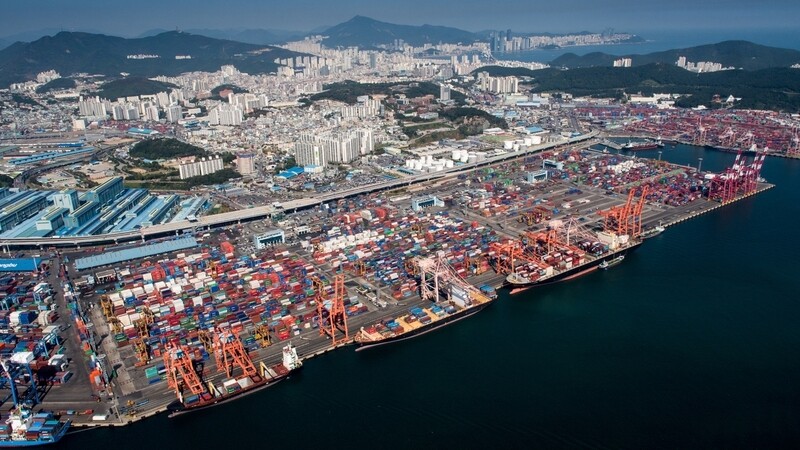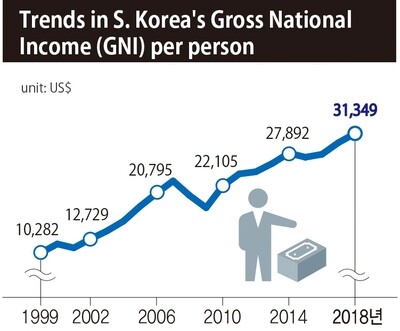hankyoreh
Links to other country sites 다른 나라 사이트 링크
[Editorial] The average national income surpassing US$30,000 isn’t felt by the average person

According to a Bank of Korea (BOK) report published on Mar. 5 on projected national income for the fourth quarter and year of 2018, South Korea’s per capita national income last year totaled US$31,349, an increase of 5.4% from US$29,745 the year before. Marking the first time per capita gross national income (GNI) has surpassed US$30,000, it comes 12 years after the US$20,000 line was passed in 2006 (at US$20,795). It’s an important achievement from a national economy standpoint. A per capita income of US$30,000 is an indicator that South Korea is now among the ranks of advanced economies. It’s also notable that South Korea has become the seventh member of the so-called “30/50 club” of economies with a per capita income in excess of US$30,000 and a population above 50 million.

But a number of things undercut what would ostensibly be a welcome result. One of them is the large influence of the exchange rate on the number passing US$30,000. In local currency, average per capita income totals 34,494,000 won, which is just 2.5% higher than last year. That explains why the effects are not so clearly felt by the public. A more fundamental reason may be the dire employment situation. The national income figures include corporation income, and while it can’t be compared with ordinary individual income, that “US$30,000” is likely to come across as someone else’s windfall from the standpoint of people facing employment difficulties. The struggles also appear poised to continue for the time being amid a lack of improvement in conditions for the automobile and shipbuilding industries, which have major employment effects.
Still another factor is deepening polarization. As recently as the fourth quarter of 2018, the income of the first quintile (the bottom-earning 20%) declined by nearly 20%, while that of the fifth quintile (the top-earning 20%) rose by over 10% – resulting in an even bigger divide between rich and poor.
If the quantitative metric of an average income over US$30,000 is to be parlayed into qualitative improvements that allow everyone to share in the gains, this will urgently necessitate improvements in the hiring situation. With job creation slack in the private sector, the government will be obliged to disburse its job budget early while continuing to focus its efforts on increased hiring in the public sector. An even better outcome would be if new jobs were created in the private sector. There will also need to be efforts to clear away some of the irrational stumbling blocks and support the development of industry ecosystems in new fields to take the place of the traditional mainstay industries, and to correct unfairness in the economic order.
Management of external risk has further emerged as a crucial task. Variables like Brexit and economic slumps in the US and China pose threats to the South Korean economy, which is heavily dependent on the outside. We need to recall that when per capita income first cleared the US$10,000 mark (US$10,168 in 1994) and US$20,000 mark, it ended up retreating substantially amid the respective effects of the foreign exchange crisis and global financial crisis.
Please direct comments or questions to [english@hani.co.kr]

Editorial・opinion
![[Column] Season 2 of special prosecutor probe may be coming to Korea soon [Column] Season 2 of special prosecutor probe may be coming to Korea soon](https://flexible.img.hani.co.kr/flexible/normal/500/300/imgdb/original/2024/0426/3317141030699447.jpg) [Column] Season 2 of special prosecutor probe may be coming to Korea soon
[Column] Season 2 of special prosecutor probe may be coming to Korea soon![[Column] Park Geun-hye déjà vu in Yoon Suk-yeol [Column] Park Geun-hye déjà vu in Yoon Suk-yeol](https://flexible.img.hani.co.kr/flexible/normal/500/300/imgdb/original/2024/0424/651713945113788.jpg) [Column] Park Geun-hye déjà vu in Yoon Suk-yeol
[Column] Park Geun-hye déjà vu in Yoon Suk-yeol- [Editorial] New weight of N. Korea’s nuclear threats makes dialogue all the more urgent
- [Guest essay] The real reason Korea’s new right wants to dub Rhee a founding father
- [Column] ‘Choson’: Is it time we start referring to N. Korea in its own terms?
- [Editorial] Japan’s rewriting of history with Korea has gone too far
- [Column] The president’s questionable capacity for dialogue
- [Column] Are chaebol firms just pizza pies for families to divvy up as they please?
- [Column] Has Korea, too, crossed the Rubicon on China?
- [Correspondent’s column] In Japan’s alliance with US, echoes of its past alliances with UK
Most viewed articles
- 1‘We must say no’: Seoul defense chief on Korean, USFK involvement in hypothetical Taiwan crisis
- 2[Editorial] Korea’s surprise Q1 growth requires objective assessment, not blind fanfare
- 3Division commander ordered troops to enter raging flood waters before Marine died, survivor says
- 4[Column] Season 2 of special prosecutor probe may be coming to Korea soon
- 5Is Japan about to snatch control of Line messenger from Korea’s Naver?
- 6S. Korea “monitoring developments” after report of secret Chinese police station in Seoul
- 7No good, very bad game for Korea puts it out of Olympics for first time since 1988
- 8The dream K-drama boyfriend stealing hearts and screens in Japan
- 9[Column] ‘Choson’: Is it time we start referring to N. Korea in its own terms?
- 10Is N. Korea threatening to test nukes in response to possible new US-led sanctions body?